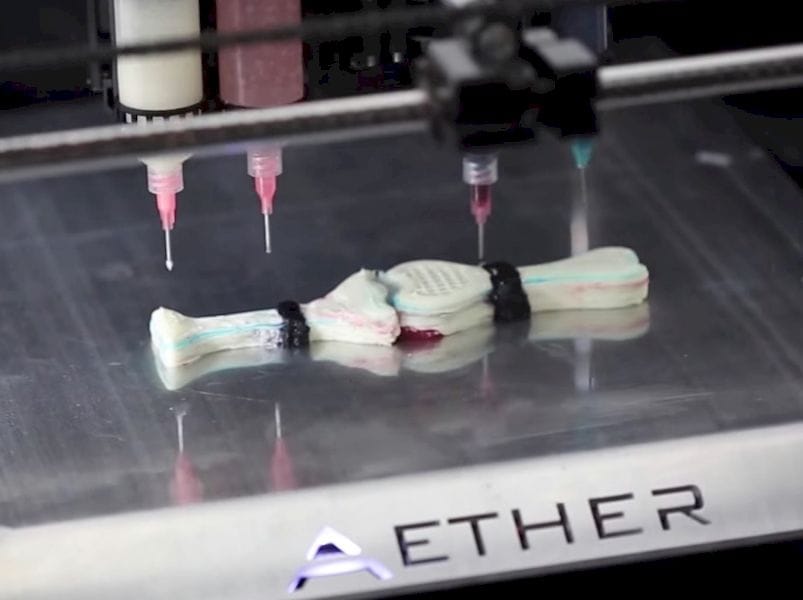
I’m looking at a very curious device, the Aether 1 3D printer, or is it a bio printer?
This unusual device is touted as a 3D printer – and as a bio printer, something I’ve never seen before. Usually devices print thermoplastic only, while bio printers include sterile syringe systems for depositing living cells and dissolvable lattice structures to hold them.
This device seems to be able to do both.
And it does it with quite a flair with a number of very unusual features.
First, the thermoplastic system. This is a dual hot end system, fed by two input thermoplastic filaments. They could 3D print a two different colors, or perhaps different material types, such as dissolvable support thermoplastic, thus enabling the ability to 3D print highly complex geometries.
So far this sounds pretty standard, but that’s not all.
The Aether 1 also includes no less than EIGHT syringe extruders, each of which can be loaded with a different pasty material. This machine could therefore, theoretically, 3D print a food item with eight ingredients. That’s about the most I’ve heard of for any 3D food printing system, but this system could also be used with several ceramic materials, as well.
However, these are syringe-based, and thus have limited capacity per print.
Another unusual feature: “All-Metal Chain and Sprocket Gantry System”. I’ve not seen this approach either, as most advanced 3D printer designs now include linear rails or similar motion systems.
But wait, there’s more. The Aether 1 also includes a “Heated Glass Syringe” system, presumably required for bio work.
In all, the company states that the system can include “10+” extruders, which presumably mean the two thermoplastic extruders and the eight syringe extruders. And apparently more, too.
The system includes “automatic stage leveling”, which I presume is something analogous to standard 3D printer bed calibration. That’s good.
But there’s also more features that are quite interesting I haven’t seen before: “Machine Vision Automatic Air-Pressure Calibration”, and “Machine Vision Automatic X/Y Offset Calibration”. This sounds like they have a camera system that optically inspects extrusions and tunes the system appropriately. That would be an excellent feature to see on any 3D printer.
The Aether 1 also includes a 7” color touchscreen, as well as WiFi networking and an air filter of some unknown design to presumably reduce the odors emitted by the system when operating.
All of this sounds like a vast array of features, does it not? Prepare yourself, there is even more.
The Aether 1 also apparently includes these additional features:
- Solenoid Microvalve Droplet Jetting Extruders (for living cell deposition)
- UV Photo Cross-linking LED (I am not sure what this is for)
- Dual automatic cleaning stations
- High resolution motors (0.4 nanometer Z-axis)
- CNC Milling
- 445nm Laser
Really?
These seem to be attached with a type of “universal adaptor”.
Thus the Aether 1 seems to be another multi-tool making device, but one that goes much farther by including bioprinting capability, non-3D printing capabilities and much more.
It’s as if you decided to put literally EVERYTHING into a single device. And they evidently have developed software to manage all this, too.
Honestly, I am a bit confused about this system; it is so dramatically different from conventional 3D printers, yet includes their features – and even a few more.
It’s possible that bioprinting applications may take advantage of the mix of materials and making tools available. One of their videos shows a prototype device printing:
This is a print of two bones connected by a tendon. Each bone is wrapped in bands of graphene. A transistor is placed in the larger bone. The transistor is connected to the band of graphene via printed electroconductive wires. Bones are seeded internally with stem cell type A. Tendon is seeded internally and externally with stem cell type B.
This is a very unusual mix of technologies that I’ve not seen previously. This type of 3D printing process mix sounds extremely complex and thus would require very complex management software, as well as considerable design and bio expertise to develop 3D models for.
All this adds up to an astonishingly complex project that I would be puzzled to see any company pull off. However, the mysterious San Francisco-based Aether Inc has been around since 2016. There seems to be very little information about this company available online.
According to previous reports, the company apparently shipped a prototype device to a university, but in recent months seems to be absent from the news entirely. It’s not clear to me whether they are continuing forward, but if so, it will almost certainly be a huge challenge.
Via Aether1

